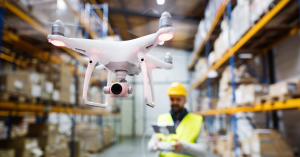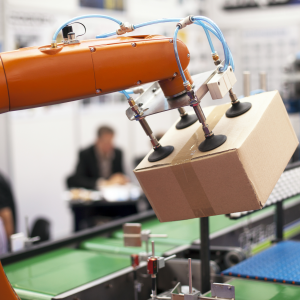Estimated reading time: 4 minutes
Since the beginning of 2020, much has taken place that has set back the supply chain, thanks to effects of the Coronavirus pandemic. Lockdown shutdowns have greatly increased to keep employees at home, working there if they have the means, and quarantining when they can to ensure that everyone stays safe, as much as they can influence. There’s been an uptick in online shopping, due to consumers finding themselves unable to stray far from their homes and with this being a known fact, warehouse employees are working more than overtime to ensure that the consumer expectations are being fulfilled and orders are getting delivered on time. Physical distancing guidelines make it extremely difficult for warehouse to continue swiftly operating with human employees, which can cause a trickle-down effect for the rest of the supply chain. With orders needing fulfilled due to the increased demand and fewer employees staffed at one time, warehouses are beginning to adopt automation technology to continue thriving and surviving in the current workplace.
Human-less Workplace
Amid the pandemic, the need for a switch to new and improved technologies has accelerated swiftly. From automated forklift vehicles to the high-quality drones, there have been several new tactics adopted in warehouse environments. Automated forklifts present an opportunity to allow such navigational technology to prosper, where an employee can ‘drive’ a forklift, without physically touching the control levers.  At the same time smart drones can be utilized to upgrade inventory manage, transportation from one dock to another, and even additional surveillance complying specifically with COVID-19 restrictions and guidelines. If a group of employees were to be found congregating too closely to each other, an alert would be sounded to make that claim known and heard throughout the work station.
At the same time smart drones can be utilized to upgrade inventory manage, transportation from one dock to another, and even additional surveillance complying specifically with COVID-19 restrictions and guidelines. If a group of employees were to be found congregating too closely to each other, an alert would be sounded to make that claim known and heard throughout the work station.
Robots have been known to perform tasks that can help simplify a human employee’s workload, especially with the social distancing needs put in place back in 2020 and still existing now in the new year. Warehouses can use any range of devices to replace works and that includes covering cleaning, transportation, mobile picking, and collaborative tasks (tasks that can shared in responsibilities.) Cleaning and disinfecting robots can accomplish tasks that can be deemed too dangerous for human employees. Robots can’t suffer from pre-existing conditions or organ failure issues, so it makes sense for the robots to be the ones that wipe down equipment after usage and disinfect working errors to keep the employees who are on the clock safe and healthy. Such procedures can be followed, especially following the notification of positive COVID-19 case(s).
Robots also possess the ability to pick items and relocate them onto conveyor belts, packaging, and more. By adopting Artificial Intelligence and computer vision, these next-level machines are able to remove human error from the equation and exhibit a better success rate, so the right person will receive exactly what they ordered. The possibilities are endless when it comes to employing robotic warehouse workers.
Keeping Workers & Parcels Safe
One of the largest changes has been how the typical workplace is set up to best promote healthy habits, and keep those who are most likely to be infected by COVID-19, at a safe and comfortable distance. Navigating through a slew of Warehouse Management Systems can be a chore, but ensuring that there is a system in place that can reduce the reliance on surrounding departments, while also allowing the current workflow to operate with fewer staff in their designated zones will help the warehouse continue to function as a well-oiled machine. That means social distancing and improved accuracy will all be taken into consideration.
Poor efficiency rates won’t look good to anyone, customer or manager and with that, there is a higher need for better picking and sorting methods to ensure that orders are filtered through with 100% accuracy. Many operators have begun to introduce batch pick flexible picking methods to cope with the heightened influx that has occurred since the start of 2020 in supply chains. When picked goods are transported into a central location, users will receive an immediate confirmation that orders have been picked accurately and that the parcel hasn’t gone missing somewhere throughout the process. This additional dosage of quality helps customers to ensure that the company processing their package knows what they are doing and can rest easy. At the other end of the equation, distribution centers can rest easy knowing all of their hard work is worth something.
COVID-19 has pushed warehouses to adopt a better understanding of automation techniques so that businesses can remain operational to meet the growing demand put in place by customers. In these unprecedented times, it can be challenging for both the consumer base and the distribution center to keep up with the overwhelming expectations, but by putting trust in technology, warehouses can overcome hurdles and obstacles. When it comes to working around phased shifts and skeleton crews to combat the virus, there’s a COVID-19 based solution to assist in this type of situation.
![]() Zebra, Cherry, and Newcastle have put their heads together to craft out the perfect Warehouse Management initiative solving the issue with Mobile Personal Printing Stations. With this line of devices, workers can move items off the dock faster than typical, and even eliminate errors by printing and applying labels right at the source, promoting safer work environments all the while. If you’re interested in learning more about how this solution can be applied, be sure to read more here.
Zebra, Cherry, and Newcastle have put their heads together to craft out the perfect Warehouse Management initiative solving the issue with Mobile Personal Printing Stations. With this line of devices, workers can move items off the dock faster than typical, and even eliminate errors by printing and applying labels right at the source, promoting safer work environments all the while. If you’re interested in learning more about how this solution can be applied, be sure to read more here.

